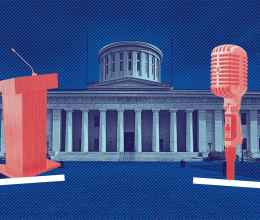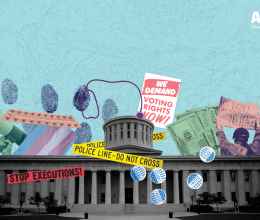Susan J. Becker is a member of the ACLU of Ohio board of directors and a volunteer attorney in the Cleveland office.
When faced with a major health threat in this country, elected and appointed officials charged with protecting public health tend to employ a false dichotomy. Our government can keep us safe or free, we are told over and over again, but cannot preserve both our safety and our freedom.
This false dichotomy should not control the government’s actions on the management of the Ebola outbreak.
Lessons From the Past
The inherent fallacy of the safe-or-free dichotomy has been proven time after time by government decision-making—at all levels—in response to actual or perceived health crises. The safe-or-free fallacy was confirmed by the forced sterilization of thousands of people with disabilities throughout the 1900s in an effort to keep us safe from genetic variations. It also was confirmed in the early 1980s when government officials proposed quarantining gay men to keep the public safe from the acquired immune deficiency syndrome (AIDS), and again when officials proposed that the United States close our border with Mexico during the H1N1 flu pandemic in 2009.
In these and myriad similar situations, medical experts counseled that the strategies favored by government officials were highly ineffective and most likely counterproductive. Legal experts decried the desecration of individual rights resulting from these strategies.
The ACLU has cautioned repeatedly that cornerstone constitutional rights, such as freedom to travel, freedom of association, freedom of speech, freedom of personal autonomy concerning medical treatment, and basic procedural due process rights, need not be blindly sacrificed in the name of safety. This is especially true when—as documented by the examples cited above—the government’s actual or contemplated actions ravage constitutional guarantees in exchange for the illusion that the government is keeping us safe.
Extensive Powers To Protect
To be sure, Ebola is a formidable foe. This debilitating and often fatal viral disease has claimed thousands of victims in Guinea, Liberia, and Sierra Leone, and it is not yet under control in those West African nations. The World Health Organization (WHO) reports that the 2014 Ebola outbreak has claimed more victims than all previous outbreaks combined since the virus’ origin in 1976.
It is equally true that our state and federal governments possess extensive powers to curtail the spread of Ebola and other contagious diseases. The government may invoke these powers to protect the general public even when doing so runs roughshod over the rights of individuals. In fact, the Supreme Court declared in its 1905 landmark decision of Jacobson v. Massachusetts that states have the power to mandate smallpox vaccinations. Jacobson and subsequent cases confirm that a state may use compulsory examination and treatment, emergency detention, civil commitment, quarantine, and other strategies that trample individual rights when those strategies are necessary to protect public health.
Emboldened by these legal determinations, Ohio and other states established extensive statutory and regulatory schemes that provide public health officials with: (1) multiple tools to combat the spread of disease; and (2) great discretion in deciding where, when, why, and how to use those tools. For example, Ohio law authorizes health officials to issue or obtain quarantine orders for persons who are or may be contagious, mandatory monitoring of health status, restrictions on travel while being monitored, mandatory disinfection of houses, and destruction of property to help stop the spread of disease.
In every instance, however, the tools employed by the state to control Ebola or any other disease must be reasonable based on the circumstances. If the state’s choice is challenged on constitutional or other grounds, the court will give substantial deference to the state’s decision if the state relied on sound medical and scientific advice in formulating and implementing its disease containment plan. Conversely, a plan grounded in misinformation and informed primarily by panic will likely be condemned by the courts.
Ebola in Ohio
Ohio officials need to keep the current situation in perspective and formulate the state’s evolving response to Ebola based on facts, not fear.
To date, only two travel-associated cases of Ebola have been confirmed in the entire country. The subsequent Ebola diagnosis of two nurses who cared for the now-deceased first victim raised significant and understandable concern, which ratcheted up to near hysteria in Northeast Ohio when news broke that one of the infected nurses had visited this region for several days in mid-October. (The nurse has now been declared Ebola free.)
As of Oct. 22, the Ohio Department of Health was continuing to monitor more than 160 people in the state who had or may have had contact with this nurse, with three people under strict home quarantine. No reports have surfaced of objections to the monitoring or quarantine, so it appears unlikely that any court battles will erupt over the propriety of the Ohio health officials’ decisions in this case.
Looking forward, it is certainly possible that Ohio officials will be confronted with additional situations in which persons infected with Ebola will have some contact with this state. Our officials must choose effective strategies for combating the disease while taking care to not fuel public fear about this virus, and not reacting in ways that trample individuals' constitutional rights in exchange for a false sense of safety.
For its part, the ACLU will remain vigilant that government actions, programs, and policies developed in response to the Ebola virus are based on solid factual and medical data rather than on misinformation and fear. We can remain both safe and free when dealing with Ebola.



